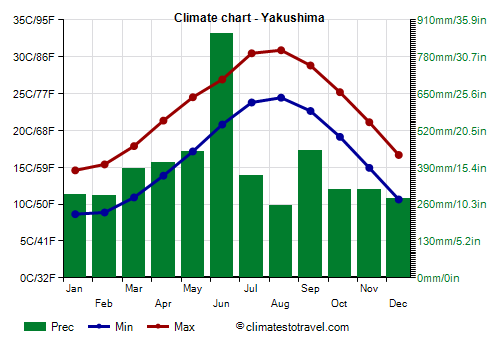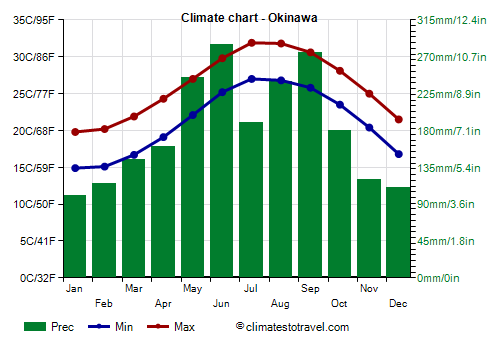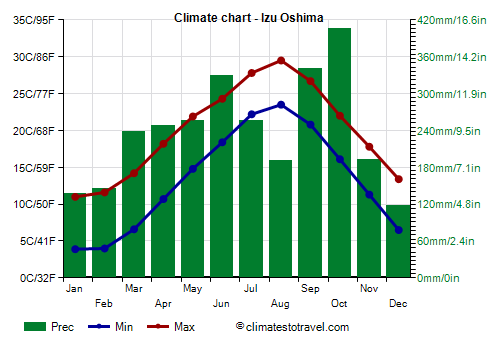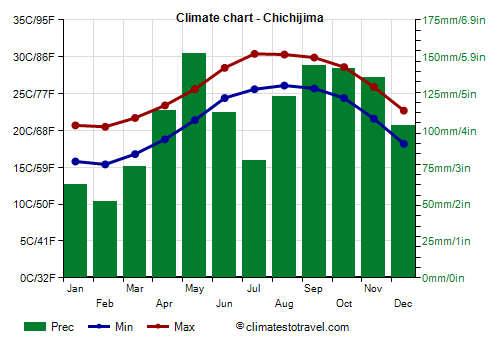Select units of measurement for the temperature and rainfall tables (metric or imperial).
Average weather, temperature, rainfall, sunshine hours
To the south of the main islands of Japan, we find some archipelagos made up of smaller islands. Generally, these islands have a
subtropical climate, with mild winters and hot, muggy summers. The rains are abundant and well distributed throughout the year.
Ryukyu
To the south of Kyushu we find the
Ryukyu Islands, in turn divided into different groups, which almost reach the Tropic, to the east of Taiwan.

Osumi

In the northernmost group of islands (
Osumi), the winter is mild, with an average in January of 11/12 °C (51/54 °F), but it's also rainy and subject to cold winds from the north-west. The main islands of the group are Yakushima, Tanegashima and Kuchinoerabu-jima. Here are the average temperatures of
Yakushima.
Yakushima - Average temperatures (1991-2020) |
| Month | Min | Max | Mean |
|---|
| January | 8.6 | 14.6 | 11.6 |
|---|
| February | 8.9 | 15.4 | 12.1 |
|---|
| March | 10.9 | 17.9 | 14.4 |
|---|
| April | 13.9 | 21.3 | 17.6 |
|---|
| May | 17.2 | 24.5 | 20.8 |
|---|
| June | 20.8 | 26.9 | 23.9 |
|---|
| July | 23.8 | 30.5 | 27.1 |
|---|
| August | 24.4 | 30.9 | 27.7 |
|---|
| September | 22.6 | 28.8 | 25.7 |
|---|
| October | 19.1 | 25.2 | 22.2 |
|---|
| November | 14.9 | 21.1 | 18 |
|---|
| December | 10.6 | 16.7 | 13.7 |
|---|
| Year | 16.4 | 22.9 | 19.55 |
|---|
The rains are particularly abundant, especially on the island of Yakushima, whose central mountain is one of the rainiest places in the world. On the coast, 4,650 millimeters (184 inches) of rain fall per year at Yakushima and 2,500 mm (100 in) at Tanegashima.
Yakushima - Average precipitation| Month | Days |
|---|
| January | 295 | 17 |
|---|
| February | 290 | 15 |
|---|
| March | 385 | 16 |
|---|
| April | 405 | 14 |
|---|
| May | 445 | 14 |
|---|
| June | 860 | 20 |
|---|
| July | 360 | 12 |
|---|
| August | 255 | 15 |
|---|
| September | 450 | 16 |
|---|
| October | 310 | 13 |
|---|
| November | 310 | 13 |
|---|
| December | 280 | 16 |
|---|
| Year | 4650 | 179 |
|---|
On these islands, the sea is cool in winter, it is warm enough for swimming (with a temperature equal to or higher than 23 °C or 73 °F) from May to November, and it becomes pleasantly warm from July to September.
Yakushima - Sea temperature| Month |
|---|
| January | 20 |
|---|
| February | 19.5 |
|---|
| March | 20 |
|---|
| April | 21 |
|---|
| May | 23.5 |
|---|
| June | 25 |
|---|
| July | 27.5 |
|---|
| August | 28.5 |
|---|
| September | 27.5 |
|---|
| October | 26 |
|---|
| November | 24"> |
|---|
| December | 21.5 |
|---|
| Year | 23.7 |
|---|
Proceeding to the south (
Tokara and
Amami islands), the winter gradually becomes milder.

On the southernmost islands (
Okinawa, see
Okinawa,
Miyako - see
Miyakojima, and
Yaeyama - see
Ishigaki), the winter is so mild as to have a spring-like flavor, even though the rains are quite abundant.
In Okinawa (see Naha), where the climate is almost tropical, the average in January is around 17 °C (63 °F). Here it never freezes or snows.
Okinawa - Average temperatures (1991-2020) |
| Month | Min | Max | Mean |
|---|
| January | 14.9 | 19.8 | 17.4 |
|---|
| February | 15.1 | 20.2 | 17.6 |
|---|
| March | 16.7 | 21.9 | 19.3 |
|---|
| April | 19.1 | 24.3 | 21.7 |
|---|
| May | 22.1 | 27 | 24.6 |
|---|
| June | 25.2 | 29.8 | 27.5 |
|---|
| July | 27 | 31.9 | 29.4 |
|---|
| August | 26.8 | 31.8 | 29.3 |
|---|
| September | 25.8 | 30.6 | 28.2 |
|---|
| October | 23.5 | 28.1 | 25.8 |
|---|
| November | 20.4 | 25 | 22.7 |
|---|
| December | 16.8 | 21.5 | 19.2 |
|---|
| Year | 21.1 | 26 | 23.55 |
|---|
Further south, in Ishigaki, the January average reaches 19 °C (66 °F).
In Okinawa, 2,000 mm (80 in) of rain fall per year, and in Ishigaki 2,100 mm (82.5 in). In both islands, there is a maximum in the period from May to September (but in which there is a decrease in July) and a relative minimum in winter, of about 100 mm (4 in) per month.
Okinawa - Average precipitation| Month | Days |
|---|
| January | 100 | 12 |
|---|
| February | 115 | 11 |
|---|
| March | 145 | 13 |
|---|
| April | 160 | 12 |
|---|
| May | 245 | 13 |
|---|
| June | 285 | 12 |
|---|
| July | 190 | 11 |
|---|
| August | 240 | 14 |
|---|
| September | 275 | 13 |
|---|
| October | 180 | 11 |
|---|
| November | 120 | 10 |
|---|
| December | 110 | 11 |
|---|
| Year | 2160 | 142 |
|---|
The
sea is never cold, in fact the water temperature reaches a minimum of 22 °C (72 °F) in February and March in Okinawa, and of 23.5/24 °C (74/75 °F) in Ishigaki, while it becomes very warm in summer.
Okinawa - Sea temperature| Month |
|---|
| January | 22.5 |
|---|
| February | 22 |
|---|
| March | 22.5 |
|---|
| April | 23.5 |
|---|
| May | 25 |
|---|
| June | 27 |
|---|
| July | 29 |
|---|
| August | 29 |
|---|
| September | 28.5 |
|---|
| October | 27 |
|---|
| November | 25.5"> |
|---|
| December | 24 |
|---|
| Year | 25.5 |
|---|
Outside of this group, to the south-east of Okinawa we find the
Daito Islands, which have a climate similar to that of Okinawa, although a little less rainy: in Minamidaito the rains amount to 1,600 mm (63 in) per year.
Izu

Further east, in the part of the Pacific Ocean to the south of Tokyo (Philippine Sea), we find the
Izu Islands (also called Tokyo Islands), which are very rainy (though not as rainy as Yakushima). In Hachijo-jima, rainfall amounts to as much as 3,000 mm (121 in) per year. However, winter is the least rainy season.

The temperature becomes progressively milder as we move south: in
Izu-Oshima it is still similar to that of the south coast of Honshu, and in fact the January average is 7 °C (45 °F).
Izu Oshima - Average temperatures (1991-2020) |
| Month | Min | Max | Mean |
|---|
| January | 3.9 | 11 | 7.4 |
|---|
| February | 4 | 11.6 | 7.8 |
|---|
| March | 6.6 | 14.2 | 10.4 |
|---|
| April | 10.7 | 18.2 | 14.4 |
|---|
| May | 14.8 | 21.9 | 18.4 |
|---|
| June | 18.4 | 24.3 | 21.4 |
|---|
| July | 22.2 | 27.8 | 25 |
|---|
| August | 23.5 | 29.5 | 26.5 |
|---|
| September | 20.8 | 26.7 | 23.8 |
|---|
| October | 16.1 | 22 | 19 |
|---|
| November | 11.3 | 17.8 | 14.6 |
|---|
| December | 6.5 | 13.4 | 10 |
|---|
| Year | 13.3 | 19.9 | 16.55 |
|---|
Further south, the January average rises to 9.5 °C (49 °F) in Miyake-jima, to 10.5 °C (51 °F) in Hachijo-jima, and to 14 °C (57 °F) in Tori-shima. The island of Nii-jima is located between Izu-Oshima and Miyake-jima.
Here are the average temperatures of
Miyake-jima.
Miyake-jima - Average temperatures (1991-2020) |
| Month | Min | Max | Mean |
|---|
| January | 7.1 | 12.1 | 9.6 |
|---|
| February | 6.9 | 12.4 | 9.6 |
|---|
| March | 9.2 | 15 | 12.1 |
|---|
| April | 12.7 | 18.6 | 15.6 |
|---|
| May | 16.2 | 21.9 | 19 |
|---|
| June | 19.5 | 24.2 | 21.8 |
|---|
| July | 23.2 | 27.8 | 25.5 |
|---|
| August | 24.3 | 29.1 | 26.7 |
|---|
| September | 22.2 | 26.7 | 24.4 |
|---|
| October | 18.4 | 22.9 | 20.6 |
|---|
| November | 14.1 | 19 | 16.6 |
|---|
| December | 9.7 | 14.6 | 12.1 |
|---|
| Year | 15.3 | 20.4 | 17.85 |
|---|
Ogasawara
To the south of the Izus we find the
Ogasawara islands or Bonin, which also stretch almost to the Tropic (except the small island of Okino Tori, which is further south), but they are not as rainy as the Ryukyus.

In
Chichi-jima, the temperatures are similar to those of Okinawa, with an average of 18 °C (64.5 °F) in January and February.
Chichijima - Average temperatures (1991-2020) |
| Month | Min | Max | Mean |
|---|
| January | 15.8 | 20.7 | 18.2 |
|---|
| February | 15.4 | 20.5 | 18 |
|---|
| March | 16.8 | 21.7 | 19.2 |
|---|
| April | 18.8 | 23.4 | 21.1 |
|---|
| May | 21.4 | 25.6 | 23.5 |
|---|
| June | 24.4 | 28.5 | 26.4 |
|---|
| July | 25.6 | 30.4 | 28 |
|---|
| August | 26.1 | 30.3 | 28.2 |
|---|
| September | 25.7 | 29.9 | 27.8 |
|---|
| October | 24.4 | 28.6 | 26.5 |
|---|
| November | 21.6 | 25.9 | 23.8 |
|---|
| December | 18.2 | 22.7 | 20.4 |
|---|
| Year | 21.2 | 25.7 | 23.4 |
|---|
At Chichi-jima and Iwo-jima, the rainfall amounts to 1.300 mm (51 in) per year; here too, in July there is a relative decrease in the rains.
Chichijima - Average precipitation| Month | Days |
|---|
| January | 64 | 11 |
|---|
| February | 52 | 8 |
|---|
| March | 76 | 10 |
|---|
| April | 113 | 10 |
|---|
| May | 152 | 12 |
|---|
| June | 112 | 9 |
|---|
| July | 80 | 9 |
|---|
| August | 123 | 11 |
|---|
| September | 144 | 13 |
|---|
| October | 142 | 14 |
|---|
| November | 136 | 12 |
|---|
| December | 103 | 11 |
|---|
| Year | 1295 | 130 |
|---|
In total, there are 2,000 hours of sunshine per year. The sunniest month is July.
Chichijima - Sunshine hours| Month | Average | Total |
|---|
| January | 4 | 130 |
|---|
| February | 5 | 140 |
|---|
| March | 5 | 160 |
|---|
| April | 5 | 150 |
|---|
| May | 5 | 150 |
|---|
| June | 7 | 205 |
|---|
| July | 8 | 245 |
|---|
| August | 7 | 215 |
|---|
| September | 6.5 | 200 |
|---|
| October | 5.5 | 175 |
|---|
| November | 4.5 | 140 |
|---|
| December | 4 | 125 |
|---|
| Year | 5.6 | 2030 |
|---|
In
Minamitori-jima, a small atoll located far to the south-east, winter is even warmer, so much so that the average in February is 22 °C (71.5 °F). Here, just 1,000 mm (40 in) of rain fall per year, with two lows of around 45 mm (1.8 in) in February and June.
Typhoons
The southern islands of Japan can be affected by
typhoons, the tropical cyclones of the western Pacific. Actually, these islands are often hit harder than Japan's main islands.
Typically, typhoons occur from June to October. Occasionally they have also occurred before and after this period (so, from late April to late May, and from early November to early December). However, they are more frequent
from August to early October.
See also the
temperatures by month.